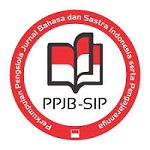Mantra Sasak: Klasifikasi, Fungsi, dan Penggunaannya oleh Masyarakat Desa Ganggelang
DOI:
https://doi.org/10.32938/jbi.v4i1.148Keywords:
verbal-spells, jejampi, Sasak, classification, functionAbstract
The purposes of this research are: (1) To classify the Sasak verbal-spells based on the variations of the language being used and the purpose of its implementation; and (2) to describe the function and its usage for the Sasak people in general and Ganggelang villagers, North Lombok in particular. This research uses a qualitative research method that both descriptive-interpretative. One of the reasons for choosing such a method is because it is compatible with the purpose of this research which is to document and describe the usage of Sasak verbal-spells. The data are collected by interviewing informants and gathering the results of the verbal-spells, its usage, and function by the Sasak people. To classify the data based on the language medium, a hermeneutic approach has been employed. The data analysis refers to perspective-constructivist model, that is directed by the intentions, categories that have been determined, and hypotheses that are aimed to be achieved. The result of this research, which is the verbal-spells then analyzed based on the language such as Arabic (verbal and written) spells, mixed between Sasak and Arabic spells, and Balinese spells or known as Puji Bali. Based on its purpose of implementation, Sasak verbal-spells are categorized into for healing purposes, Senggeger: a type of voodoo to attract the loved ones, Seasih-asih: to make one falls in love, supernatural power, and draining someone’s (physical) energy/power. Based on its function and practical usage, the Sasak verbal-spells have functions as healing/preventing diseases, to Seasih-asih purposes, to Senggeger/sencolet purposes, as a medium to ease childbirth processes, to counter other’s spells (sengkeles), and to counter possible dangers or destructions (sepenebeng/ajian kekebalan) and to drain someone’s energy.
References
Alisjahbana, St. Takdir. 2008. Puisi Lama. Jakarta: PT. Dian Rakyat
Alwi, Hasan. 2005. Kamus Besar Bahasa Indonesia Cetakan keempat. Jakarta: Balai Pustaka
Badudu, J.S. 1983. Sari Kesusastraan Indonesia 2. Bandung: Pustaka Prima
Fakihuddin Lalu. 2015. “Eksistensi Masalah Supranatural dalam Folklor Lisa Sasak: Suatu Kajian Tematis terhadap Cerita Rakyat Sasak yang Telah Didokumentasikan. “ (Jurnal Mabasan Volume 9, No.2, Juli—Desember 2015)
Mantra, I.B.N. dan Sri Widiastuti, I.A.Md. , Jurnal Bakti Saraswa Vol.03 No.02. September 2014 ISSN : 2088-2149)
Purba, Th.T. dkk. Morfologi Bahasa Dani Barat. Direktorat Pembinaan Penelitian dan Pengabdian Pada Masyarakat Doirektorat Jenderal Pendidikan Tinggi, Departemen Pendidikan dan Kebudayaan.
Depdikbud. 1986. Sastra Lisan Sasak. Rawamangun: Pusat Pembinaan dan Pengembangan Bahasa
Rahmanto, B. 1993. Metode Pengajaran Sastra. Yogyakarta: Kanisius
Rafiek, M. 2010. Teori sastra: Kajian Teori Dan Tematik. Bandung: PT Rafika Aditama
Rizky Novia C.W dkk. Fungsi “Mantra Pengobatan Di Desa Kuala Lagan Kecamatan Kuala Jambi Kabupaten Tanjung Jabung Timur Provinsi Jambi” . Program Studi Sastra Indonesia FIB Universitas Jambi
Semi, Atar. 1993. Metode Penelitian Sastra. Bandung: Penerbit Angkasa.
Shipley, J.T. 1962. Dictionary of World Literatur. Littlefield, Adams & Co Patterson, New Jersy.
Sudjiman, Panuti. 1990. Kamus Istilah Sastra.Jakarta: UI-PRESS.
Suhendra, Yusuf 1995. Leksikon Sastra. Bandung: Mandar Maju.
Downloads
Published
How to Cite
Issue
Section
License
Penulis yang mengirimkan naskahnya pada Jubindo telah memahami ketentuan yang berlaku pada jurnal ini. Jika naskah tersebut diterbitkan, hak cipta artikel itu akan diserahkan kepada Jubindo dan Universitas Timor sebagai penerbit jurnal tersebut.
Hak cipta ini meliputi hak eksklusif untuk mereproduksi dan menyiarkan artikel dalam berbagai bentuk media. Reproduksi sebagian atau keseluruhan isi jurnal ini dan segala yang melekat padanya haruslah dengan seizin Jubindo dan Universitas Timor.
Jubindo dan Universitas Timor, Dewan Editor, dan Reviewer berusaha menjamin agar tidak terjadi kesalahan atau penyimpangan dalam penyajian data dan pernyataan yang dikutip pada jurnal. Dalam hal naskah yang termuat berisi penghargaan pada pihak-pihak tertentu sebagai donatur atau sponsor, itu merupakan bagian yang terpisah dari Jubindo dan menjadi kepentingan penulis dengan pihak sponsor.
Semua artikel yang dimuat dalam jurnal ini bersifat Open Access dan bebas dibaca, diunduh, dan disebarluaskan oleh para pembaca selama tidak mengabaikan lisensi yang diacu oleh Jubindo: yaitu http://creativecommons.org/licenses/by-sa/4.0









